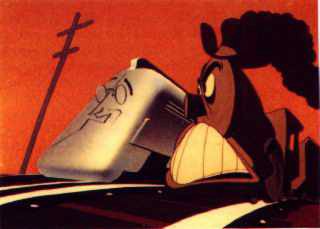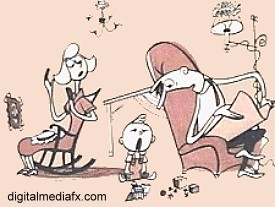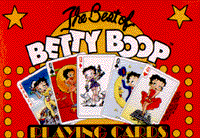Starting the Discussion
The Dawning
of the TV Cartoon: UPA and Jay Ward
Maltin,
pp. 323-342; Klein, pp. 229-254
Maltin
- When a group of animators,
formerly employed at the Disney studio, wrote in The Animator, that
animation "is an expressive and not a mechanical medium," what did
they mean? How did this statement set the scene for the revolution in animation
that would take place at UPA?

- What made Hell Bent
for Election such a groundbreaking film? What about its production process
made it even more interesting?
- As Maltin describes
the early productions of UPA, you should be putting together a list of the
stylistic qualities that distinguished UPA style from the traditional Disney
or Warner Brothers style.
- How was Mr. Magoo developed,
and how did he change for the worse over the years?
- When critic Gilbert
Seldes proclaimed that Gerald McBoing Boing was "a return to
the principles of the animated cartoon," what did he mean? What are "the
fundamentals" that Disney "has abandoned," in Seldes' opinion?
- What, according to Seldes,
are the positive virtues of the UPA style? In what way were the best of their
productions able to unite form and content to produce a coherent and satisfying
whole?
- Unlike Disney, UPA at
least partly subsidized its animated film division by doing commercial art
and design; what kinds of work did they do?
- After a number of years
of making highly individual and often unique animated shorts, UPA began to
die. What happened to cause the virtual end of the studio (though its properties
were eventually purchased by a new producer, Henry Saperstein) within a year
or so of their highest earnings and productivity?
- What, finally, was the
contribution of the UPA artists to the history and art of animation?
Klein
- The subtitle of this
reading, "When Pigs and Bunnies Collide with Nuts and Bolts," strikes
me as particularly apt for a discussion of UPA. When John Hubley notes that
"line, shape, color and symbols in movement can represent the essence
of an idea," how does he pave the way for the concept of stylized animation
as practiced in the 1950s?

- How did this stylistic
concept change the then-current style of full animation? (This would be a
good time to remind ourselves of the differences in full animation as practiced
by the two major studios, Disney and Warner Brothers.)
- How is stylized animation
different from the early animation based on graphic line and gag structure
(linear animation)?
- In what sense does stylized
animation reflect a new way to understand space?
- Many of the animators
at UPA had begun their careers at Disney; the majority had worked on Fantasia.
What caused them to leave Disney? How did their liberal democratic beliefs
shape their art?
- We'll be watching Gerald
McBoing-Boing in class; as you read, note the qualities Klein believes
make it "the quintessential UPA product."
- How might Gerald be seen
as an individual emblematic of life in the post-war US?
- In the world of UPA cartoons,
Klein observes, "The conflict is displayed by watching how the inside
(the self) colors outside (the void). What is he suggesting here?
- What did the UPA artists
use instead of full animation to give their cartoons vitality?
- "UPA," Klein
concludes, "was a brilliant look at repression, consumer normalcy and
the new topology of the 1950s--a world that promised freeways, housing projects,
and a mechanistic normalcy, but was stricken by anxiety, like those little
UPA characters." Can you relate this comment to some of Schickel's in
The Disney Version?
- On p. 241, Klein summarizes
his central points; we'll be discussing them in class.
- In the last section,
we eulogize the theatrical cartoon short, which died in about 1956 in the
US, at the end of a fifteen year period when production costs had risen 225%,
while rentals had risen only 15%. Where did the erstwhile theatrical animators
go then?
- If Disney was the Tiffany's
of cartoon studios and Paul Terry was the Woolworth's, what does it mean that
Hanna Barbera was the Lockheed?
- What style did Hanna
Barbara favor? Where have we seen that style before? How did limited animation
compare to the stylized animation of UPA?
- Once theatrical cartoon
shorts and their characters were out of production, they experienced a lively
afterlife. Where did cartoons, animators and the major characters go (predictably)
starting in the 1970s? Why might such a renaissance occur then?
- What kind of real space
do live action and animated characters now inhabit? What added attraction
for the consumer do they represent?
- If you go back to Schickel's
final comments on Disney's impact on the child who consumes his product, what
echo of that complaint can you find in Klein's observation that the more participatory
versions of animation "announce that someone else has pre-programmed
your unconscious"? Where else in American pop culture can you find this
complaint echoed?
Back
to Home Page



